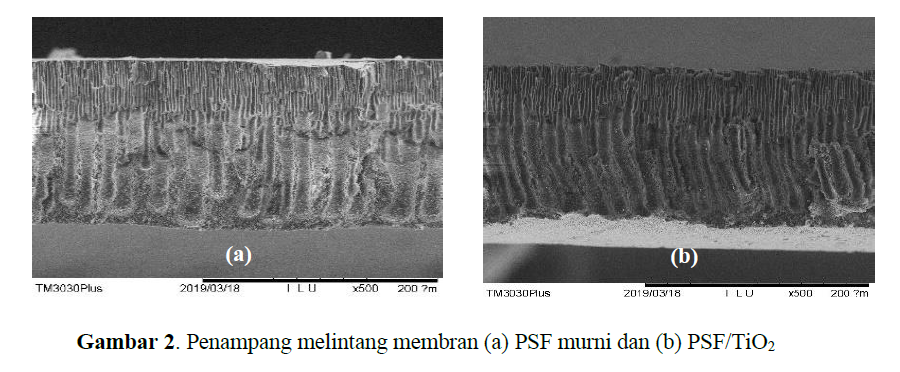Ultrafiltration Membrane Of Polysulfone/ TiO2 (Psf/TiO2) For Diesel Fuel Polluted Water Filtration
Membran Ultrafiltrasi Polisulfon/TiO2 (Psf/TiO2) Sebagai Filter Pada Pencemaran Air Oleh Bahan Bakar Solar
Abstract
Membrane is an important part in ultrafiltration process to split up water from its impurities. Commonly membranes are made of polymer which has adequate resistance in filtration process. One type of them is polysulfone. Good physical endurance is its supremacy as material in the manufacture of membranes. Nevertheless, the hydrophobic nature of polysulfone makes membrane performance less efficient. Blending process using TiO2 can lessen the hydrophobicity of polysulfone, but still maintain membrane primacy. The blending process was carried out by the phase inversion method. Membrane physical structure was observed by SEM and XRD analysis. The pore arrangement on both membranes looks asymmetric. However, the PSF/TiO2 membrane has more systematic pore disposition. Good crystallinity was noticed on PSF/TiO2 membranes with crystal size of 27 nm whereas pure polysulfone looks more amorphous. Membrane performance can be discerned by considering various parameters after performance tests by using diesel fuel emulsion in water. Some of these parameters include flux, rejection, and total fouling after the emulsion filtration process. PSF/ TiO2 membrane flux values showed better results at 21.05 L/m2 hour. Rejection of the PSF/TiO2membrane looked better as well, spesifically 70,857%. Total fouling showed preferable result on the PSF/TiO2 membrane, which was 42.34%. The insertion of TiO2by a composition of 10% of the total PSF used can improve membrane performance and morphology.
Keywords: Filtration, Flux, Membrane, polysulfone, TiO2
References
Rosnelly CM. Pengaruh Rasio Raditif Polietilenglikol Terhadap Selulosa Asetat pada Pembuatan Membran Selulosa Asetat Secara Inversi Fasa. J Rekayasa Kim dan Lingkung. 2012.
Mulyati S, Takagi R, Fujii A, Ohmukai Y, Maruyama T, Matsuyama H. Improvement of the antifouling potential of an anion exchange membrane by surface modification with a polyelectrolyte for an electrodialysis process. J Memb Sci. 2012. 417–418:137–43. http://dx.doi.org/10.1016/j.memsci.2012.06.024
Japonika H. Pemisahan dengan Membran Ultrafiltrasi dalam Industri Bioproses. :1–8.
Zhong L, Gao Y, Li B, Zhang L. Preparation of hydrophilic polysulfone porous membrane by use of amphiphilic cellulose. J Appl Polym Sci. 2014. :n/a-n/a. http://dx.doi.org/10.1002/app.41664
Leng C, Han X, Shao Q, Zhu Y, Li Y, Jiang S, et al. In Situ Probing of the Surface Hydration of Zwitterionic Polymer Brushes: Structural and Environmental Effects. J Phys Chem C. 2014. 118(29):15840–5. http://dx.doi.org/10.1021/jp504293r
Chen P-C, Xu Z-K. Mineral-coated polymer membranes with superhydrophilicity and underwater superoleophobicity for effective oil/water separation. Sci Rep. 2013. 3:2776. https://pubmed.ncbi.nlm.nih.gov/24072204






















